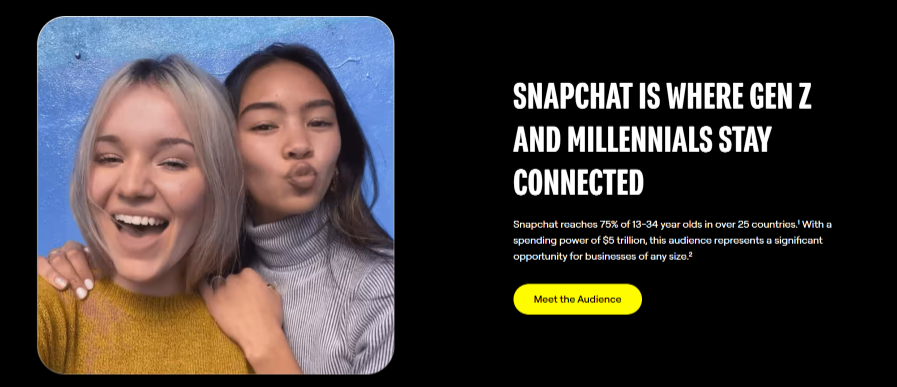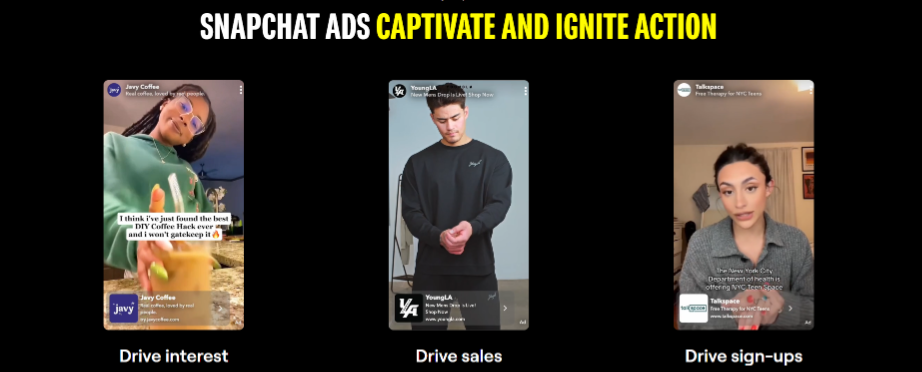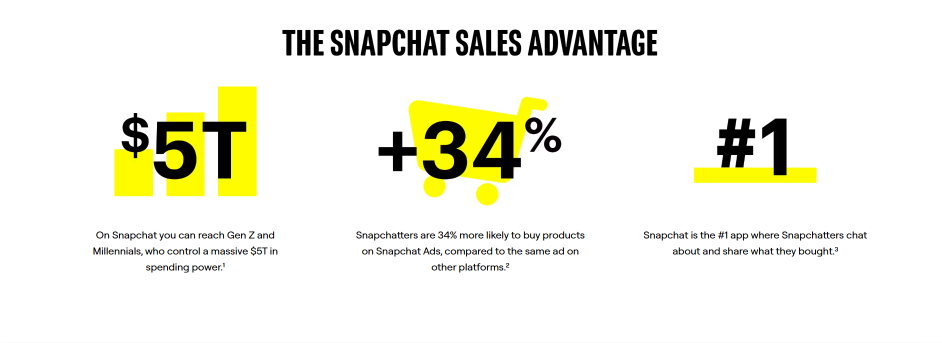There are no items in your cart
Add More
Add More
| Item Details | Price | ||
|---|---|---|---|
In this age of digital marketing, Snapchat has become the go-to platform for almost every business, just for the sole reason that it has a user base of 850 million active monthly users in the age group of 15-34.
Apart from this, it allows you to promote products through multiple content formats, while you can also use tools like augmented reality (AR) effects and sponsored lenses to leverage your marketing campaign further. And since the launch of Snap Ads, it has become a budget-friendly platform for ideal millennials and Gen Z audience, so in today's blog,
And since the launch of Snap Ads, it has become a budget-friendly platform for ideal millennials and Gen Z audience, so in today's blog,
1. Single Image or Video Ads
Snapchat offers a range of ad types, like Single image or video ads, collection ads, story ads, commercials, and AR ad types like lenses.
They are the most basic format, which appears as full-screen vertical content, specifically customized for mobile users.
2. Collection Ads:
This is suited for product catalogs, as it allows showcasing multiple products in a single ad.
3. Story Ads:
They appear within the discover section, and they offer longer form storytelling opportunities.
4. AR Lenses and Filters:
It focuses on giving the customers an augmented reality experience with their products, which in turn creates viral marketing opportunities.
5. Dynamic Ads:
It automatically generates ads with the information from your existing product catalog, and hence it becomes ideal for retargeting.
Ad specifications and technical requirements:
Generally, Snapchat ads use a vertical 9X16 format, suited for a phone screen, as it is a much larger customer base of smartphone users
However, you can change the specs according to your preference for each ad type.

For video ads ranging from 3-180 seconds, Snapchat recommends using the first 3-5 seconds of the video for product placement, as a high chance that users might skip them.
Snapchat has three objective categories:
All these objectives help you optimize your campaigns for different business goals.
Awareness: Brand Awareness, reach.
Consideration: Traffic, app installs, video views.
Conversions: Conversions, catalog sales, app installs.
Snapchat provides vast targeting opportunities where you can target your ideal audience using snapchats targeting tools, filtering people by location, demographics, interests, and devices.
Additional targeting features include:
- Targeting Options; including preferences interests like location, gender, age, interests, device type.
- Custom audiences from customer lists
- Lookalike audiences
- Behavioural targeting based on Snapchat activity.
Snapchat ads costs and budgeting:
Current cost metrics (2025)
In January 2025, the cost of Snapchat ads is 6.72 CPM. The cost per link click (CLPC) is 1.04.
The link click-through (LCTR) is 0.64.
Minimum Budget Requirements:
The Minimum spend per day, as available on Snapchat, is 5 dollars, although we would recommend 20-50 per day.
This amount would help you speedrun your exploration/learning phase of the ad campaign.
1. Access Snapchat Ads Manager:
Create your business account and access the ads manager platform, which would serve as your campaign control center.
2. Choose your objective:
You can select from awareness, consideration, or conversion objectives based on your business goals.
3. Define your target audience:
Use the predefined Snapchat targeting options to define your ideal customer demographics, interests, and behaviours.
4. Create your Ad creative:
You can create ad creatives with your creative mind, hire a marketing team, or use tools provided by Snapchat, like Snap Publisher.
5. Set your budget and schedule
Determine your budget and campaign duration, along with the number of days you want that campaign to work.
READ MORE: How to Run X Ads. A complete guide
While Snapchat gives many tools and targeting options for better ad campaigns, here are some practices to keep in mind to ensure that your campaign performs even better:
Creative guidelines:
- Strong CTA: Include clear calls to sign up, shop, watch more, enter, etc.
- Create vertical, mobile-first content.
- Hook viewers within the first 3 seconds with strong product placement.
- Use bright, eye-catching visuals
- Keep text minimal and readable on mobile devices.
Performance Optimization:
- Measure conversions: Track all the data related to the ad campaign, such as sales, leads, and sign-ups, accurately.
- Test different ad formats and creative variations
- Monitor your ads during the learning phase
- Adjust budgets based on performance data
- Use the automatic bidding strategies in the initial phase.
AR advertising:
Snapchat’s AR capabilities set it apart from various other platforms, allowing brands to create immersive experiences that users can interact with and share.
Pixel Tracking:
Install the Snapchat pixel on your website as it would help you track conversions, build custom audiences, and optimize for specific actions.
Dynamic product ads:
Connect your product catalog so that you are shown relevant products automatically to users who have shown interest in your brand.
As I told you before, to measure your success, you need to track some key metrics periodically and try to make them better.
The Key metrics that need tracking are:
- Cost per thousand impressions(CRM)
- Click through rates(CTR)
- Cost per click(CPC)
- Conversion rates
- Return on ad spend(ROAS)
- Engagement rates for AR lenses and filters

As Snapchat offers unique opportunities to reach younger demographics, preferably the 18-34 age group, through various methods like innovative ad formats, like AR experiences.
With much lower entry costs than other platforms like Meta Ads and highly customizable targeting options, it becomes an accessible platform for businesses of all sizes.
With all the features available, Success requires understanding the platform’s creative requirements, your target audience, and optimizing the ad creative for mobile-first experiences, and then leveraging Snapchat’s unique features like AR lenses and vertical video formats.
So, in conclusion, I would say the key to Snapchat advertising success lies in creating authentic, engaging content that would feel natural for the platform while utilizing the extensive targeting and measurement tools available to further optimize campaign performance.

DAMINI TRIPATHI
Damini Tripathi, rocking the digital marketing scene for 5 awesome years. Started from scratch, now running my digital marketing agency and creating cool content too. She has been one of the fastest-growing digital marketers on the internet. Damini has also scaled multiple clients from ZERO —> HERO.